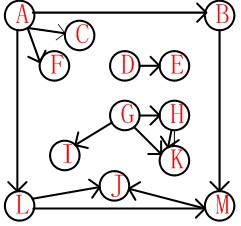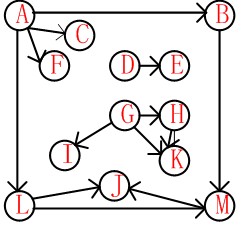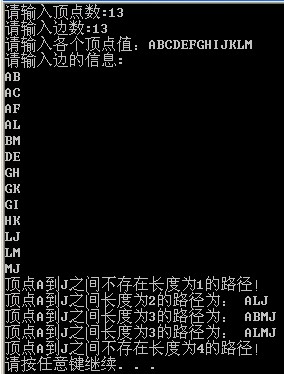c++有向图中顶点的路径问题。
主要解决三个问题:
前提:有向图+邻接矩阵存储
问题1、判断有向图中是否存在顶点u到v的路径
问题2、求u到v的所有简单路径
问题3、求u到v长度为k的简单路径
具体如下:
问题1:判断有向图中是否存在顶点u到v的路径
方法:可以使用深度遍历或广度遍历
源代码:
[cpp] view plaincopy
- #include <iostream>
- using namespace std;
- const int MAX_Vertex_Num = 20;
- template<class VexType,class ArcType>
- class MGraph
- {
- public:
- void CreateGraph();//创建图
- int LocateVex(VexType v);//返回顶点v所在顶点向量中的位置(下标)
- bool getPathiToj(VexType u1,VexType u2);
- private:
- VexType vexs[MAX_Vertex_Num];//顶点向量
- ArcType arcs[MAX_Vertex_Num][MAX_Vertex_Num];
- int vexnum;//顶点数
- int arcnum;//边数
- private:
- void getPathiToj_DFS(int x,int y,int num,bool& isFind,bool visited[MAX_Vertex_Num],int path[MAX_Vertex_Num]);//借助DFS的思想实现
- };
- template<class VexType,class ArcType>
- void MGraph<VexType,ArcType>::CreateGraph()
- {
- VexType first;
- VexType Secend;
- cout<<”请输入顶点数:”;
- cin>>vexnum;
- cout<<”请输入边数:”;
- cin>>arcnum;
- cout<<”请输入各个顶点值:”;
- for (int i=0;i<vexnum;i++)
- {
- cin>>vexs[i];
- }
- //初始化邻接矩阵
- for (int i=0;i<arcnum;i++)
- {
- for (int j=0;j<arcnum;j++)
- {
- arcs[i][j]=0;
- }
- }
- cout<<”请输入边的信息:”<<endl;
- for (int i=0;i<arcnum;i++)
- {
- cin>>first>>Secend;
- //如果边有权值的话,则还应该输入权值
- int x = LocateVex(first);
- int y = LocateVex(Secend);
- arcs[x][y]=1;//如果是有权的话,这里应该是arc[x][y]=权值
- //arcs[y][x]=1;//无向图是对称的
- }
- }
- /*
- 参数:v:表示顶点向量中一个值
- 函数返回值:函数返回v在顶点向量中的下标
- */
- template<class VexType,class ArcType>
- int MGraph<VexType,ArcType>::LocateVex(VexType v)
- {
- for (int i=0;i<vexnum;i++)
- {
- if (vexs[i]==v)
- {
- return i;
- }
- }
- return -1;
- }
- /*
- 返回顶点u1到u2之间的路径
- 参数:
- u1:表示起始顶点
- u2:表示终点顶点
- */
- template<class VexType,class ArcType>
- bool MGraph<VexType,ArcType>::getPathiToj(VexType u1,VexType u2)
- {
- bool isFind=false;
- int num=0;//两个顶点存在路径时,之间的顶点数
- int x = LocateVex(u1);
- int y = LocateVex(u2);
- bool visited[MAX_Vertex_Num]={false};
- int path[MAX_Vertex_Num];
- visited[x]=true;
- path[0]=x;
- getPathiToj_DFS(x,y,num+1,isFind,visited,path);
- return isFind;
- }
- /*
- 返回 x指向的起始顶点 到 y指向的终点顶点 的所有路径
- 参数:
- x表示起始顶点的坐标,一直在变化
- y表示终点顶点的坐标,一直保持不变
- num:现在路径中的顶点个数
- visited数组:表示每个顶点是不是已经访问过
- path数组:用来存放每条路径
- */
- template<class VexType,class ArcType>
- void MGraph<VexType,ArcType>::getPathiToj_DFS(int x,int y,int num,bool& isFind,bool visited[MAX_Vertex_Num],int path[MAX_Vertex_Num])
- {
- for (int j=0;j<vexnum;j++)
- {
- if (arcs[x][j]==1 && visited[j]==false)
- {
- path[num]=j;//每遇到一个顶点都要该顶点都放到数组中
- visited[j]=true;
- if (j==y)//到达目的节点,输出路径
- {
- isFind = true;
- cout<<”顶点”<<vexs[0]<<”到”<<vexs[j]<<”的路径为:”;
- for (int i=0;i<num+1;i++)
- {
- cout<<vexs[path[i]];
- }
- cout<<endl;
- //找到终点,此时本次查找结束
- }
- else//当没有找到时,要继续往下一层寻找
- {
- getPathiToj_DFS(j,y,num+1,isFind,visited,path);//无论此时找没找到终点,总是要往下走的
- }
- visited[j]=false;//回溯,恢复现场。当走下一次循环时,要把上一次递归过程中访问到的结点都恢复到起始状态,重新处理
- }
- }
- }
- int main()
- {
- MGraph<char,int> G;
- G.CreateGraph();
- if (!G.getPathiToj(‘A’,'J’))
- {
- cout<<”A到J之间不存在路径!”<<endl;
- }
- if (!G.getPathiToj(‘A’,'G’))
- {
- cout<<”A到G之间不存在路径!”<<endl;
- }
- system(“pause”);
- return 1;
- }
结果测试:
有向图:

输出结果:

问题3、
方法:使用回溯法
源代码:
[cpp] view plaincopy
- #include <iostream>
- using namespace std;
- const int MAX_Vertex_Num = 20;
- template<class VexType,class ArcType>
- class MGraph
- {
- public:
- void CreateGraph();//创建图
- int LocateVex(VexType v);//返回顶点v所在顶点向量中的位置(下标)
- bool getPathiToj(VexType u1,VexType u2,int k);
- private:
- VexType vexs[MAX_Vertex_Num];//顶点向量
- ArcType arcs[MAX_Vertex_Num][MAX_Vertex_Num];
- int vexnum;//顶点数
- int arcnum;//边数
- private:
- void getPathiToj_DFS(int x,int y,int num,int k,bool& isFind,bool visited[MAX_Vertex_Num],int path[MAX_Vertex_Num]);//借助DFS的思想实现
- };
- template<class VexType,class ArcType>
- void MGraph<VexType,ArcType>::CreateGraph()
- {
- VexType first;
- VexType Secend;
- cout<<”请输入顶点数:”;
- cin>>vexnum;
- cout<<”请输入边数:”;
- cin>>arcnum;
- cout<<”请输入各个顶点值:”;
- for (int i=0;i<vexnum;i++)
- {
- cin>>vexs[i];
- }
- //初始化邻接矩阵
- for (int i=0;i<arcnum;i++)
- {
- for (int j=0;j<arcnum;j++)
- {
- arcs[i][j]=0;
- }
- }
- cout<<”请输入边的信息:”<<endl;
- for (int i=0;i<arcnum;i++)
- {
- cin>>first>>Secend;
- //如果边有权值的话,则还应该输入权值
- int x = LocateVex(first);
- int y = LocateVex(Secend);
- arcs[x][y]=1;//如果是有权的话,这里应该是arc[x][y]=权值
- //arcs[y][x]=1;//无向图是对称的
- }
- }
- /*
- 参数:v:表示顶点向量中一个值
- 函数返回值:函数返回v在顶点向量中的下标
- */
- template<class VexType,class ArcType>
- int MGraph<VexType,ArcType>::LocateVex(VexType v)
- {
- for (int i=0;i<vexnum;i++)
- {
- if (vexs[i]==v)
- {
- return i;
- }
- }
- return -1;
- }
- /*
- 返回顶点u1到u2之间的路径
- 参数:
- u1:表示起始顶点
- u2:表示终点顶点
- */
- template<class VexType,class ArcType>
- bool MGraph<VexType,ArcType>::getPathiToj(VexType u1,VexType u2,int k)
- {
- bool isFind=false;
- int num=0;//两个顶点存在路径时,之间的顶点数
- int x = LocateVex(u1);
- int y = LocateVex(u2);
- bool visited[MAX_Vertex_Num]={false};
- int path[MAX_Vertex_Num];
- visited[x]=true;
- path[0]=x;
- getPathiToj_DFS(x,y,num+1,k,isFind,visited,path);
- return isFind;
- }
- /*
- 返回 x指向的起始顶点 到 y指向的终点顶点 的所有路径
- 参数:
- x表示起始顶点的坐标,一直在变化
- y表示终点顶点的坐标,一直保持不变
- num:现在路径中的顶点个数
- visited数组:表示每个顶点是不是已经访问过
- path数组:用来存放每条路径
- */
- template<class VexType,class ArcType>
- void MGraph<VexType,ArcType>::getPathiToj_DFS(int x,int y,int num,int k,bool& isFind,bool visited[MAX_Vertex_Num],int path[MAX_Vertex_Num])
- {
- for (int j=0;j<vexnum;j++)
- {
- if (arcs[x][j]==1 && visited[j]==false)
- {
- path[num]=j;//每遇到一个顶点都要该顶点都放到数组中
- visited[j]=true;
- if (j==y && num==k)//到达目的节点,输出路径(num表示结点个数,k表示边的个数,但是要注意num=1时,表示有两个顶点)
- {
- isFind = true;
- cout<<”顶点A到J之间长度为”<<k<<”的路径为: ”;
- for (int i=0;i<num+1;i++)
- {
- cout<<vexs[path[i]];
- }
- cout<<endl;
- //找到终点,此时本次查找结束
- }
- else//当没有找到时,要继续往下一层寻找
- {
- getPathiToj_DFS(j,y,num+1,k,isFind,visited,path);//无论此时找没找到终点,总是要往下走的
- }
- visited[j]=false;//回溯,恢复现场。当走下一次循环时,要把上一次递归过程中访问到的结点都恢复到起始状态,重新处理
- }
- }
- }
- int main()
- {
- MGraph<char,int> G;
- G.CreateGraph();
- for (int k=1;k<5;k++)
- {
- if (!G.getPathiToj(‘A’,'J’,k))
- {
- cout<<”顶点A到J之间不存在长度为”<<k<<”的路径!”<<endl;
- }
- }
- system(“pause”);
- return 1;
- }
结果测试:
有向图:

结果:
